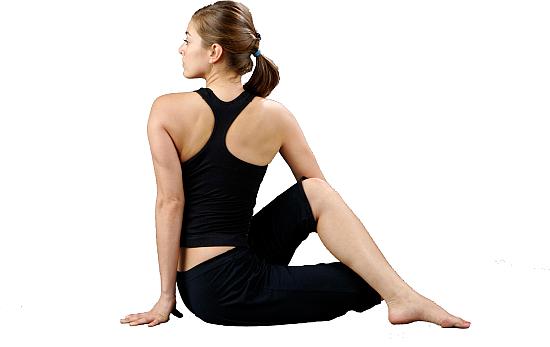Ardha Matsyendrasana is known as the half lord of the fish posture, since Ardha in Sanskrit means half, Matsya means fish and Indra is divine ruler. Matsyendra was a legendary Yogi, who taught this asana first to Hatha Yoga students. It is believed that Yogi Matsyendra was a disciple of Lord Shiva.
Once Lord Shiva went to a lonely island with his consort, Goddess Parvati and he taught her the mysteries of Hatha Yoga there. A fish swimming at the shore nearby heard all the teachings of Lord Shiva and Shiva recognized this. He took mercy on the fish and sprinkled holy water on the fish. By the grace of Shiva, the fish became a Yogi with a divine body and earned the name Matsyendra. This asana is a half posture and a spinal twist asana.
Procedure for Ardha Matsyendrasana
- You should sit with your legs straight on a blanket or a yoga mat and the legs should be spread outwards. You could use an additional folded blanket to support your buttocks for more comfort.
- You should now slowly slide the left foot under the right leg, so that you are able to reach the outside of your right hip with the left foot. You should keep the outside of your left leg on the ground after sliding it.
- You should now cross the right leg over your left leg so that it stands on the floor outside the left hip. The right knee should be pointing towards the ceiling.

- You should keep your right hand behind your buttocks and press it on the ground. Simultaneously, you should twist towards the direction of the inner portion of your right thigh, while exhaling. Your left upper arm should rest on your right knee pointing towards the ceiling. You should pull your chest and the right thigh together.
- You should press your inner right foot into the ground, while releasing your right groin simultaneously. You should also lengthen your right chest area. You should continue the lengthening of your tailbone, while leaning the upper chest slightly backwards.
- You can turn your head either towards the right or left. You can continue to twist your chest with the head or you can counter twist the chest in the opposite direction. You should be looking over your left shoulder towards your right foot if you are turning your head towards the left.
- You should lift a little through your sternum with each inhaling breath. You can press your fingers against the ground for support. You should more with each exhalation. You should ensure the twist is spread evenly throughout your spine, instead of getting concentrated in any specific area of your spine. You can stay in this pose between 30 seconds to a minute and slowly release the position with exhalation to return to the original position.
- You should repeat this asana for your left side and follow the same procedure.
Precautions and Contraindications for Ardha Matsyendrasana
Persons suffering from spinal injuries should not perform this asana. If you are having back pain, you can do this asana under the guidance and assistance of an expert yoga master.
Benefits of Ardha Matsyendrasana
Ardha Matsyendrasana stimulates the kidneys and liver, regulating their function. It energizes the spine, making it flexible but strong. It stretches your shoulders, neck and hips. This asana stimulates the digestive fire (Jaadaragni) in your abdomen and increases appetite and digestion. Ardha Matsyendrasana is a very good relief for menstrual discomfort, backache, sciatica and fatigue. It is therapeutically effective for infertility and asthma. Traditional texts on Hatha Yoga assert that Ardha Matsyendrasana can destroy most deadly diseases and awaken Kundalini.
Variation of Ardha Matsyendrasana
You can increase the intensity of Ardha Matsyendrasana by bending or straightening the knee based on comfort level. You can also enhance the effect of the asana by lifting your chest so that the spine gets straightened and stretched. If you find it difficult in the initial stages to perform this asana, you can decrease its intensity by keeping your foot on the inside portion of the knee. Otherwise, you can keep your lower leg straight and keep your upper foot on the outside or inside of your leg.
Preparatory and Follow-Up Asanas
The preparatory asanas for Ardha Matsyendrasana are Baddha Konasana, Janu Sirasasana, Virasana, Supta Padangustasana and Bharadvajasana, since they prepare your body for the intense twist required for this asana. The follow-up asanas for Ardha Matsyendrasana are Pashchimottasana and Janu Sirasasana and these asanas help in eliminating the stress that you experience in your various body parts due to the intensity of this asana. You should perform this asana as well as all other asanas only under the supervision and instructions of a trained yoga master until you achieve perfection in each asana.
